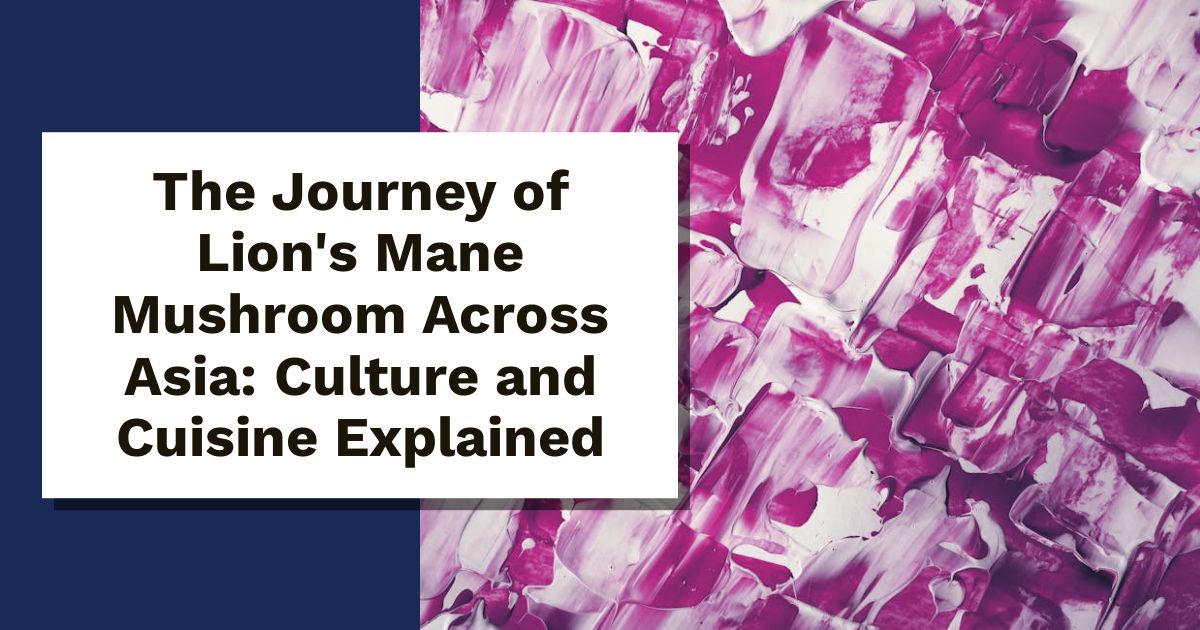Imagine wandering through a vibrant Asian market, the air filled with rich aromas and colorful sights. Among the exotic offerings, one stands out—the Lion’s Mane mushroom. With its fluffy, cascading appearance, this unique fungi has captured hearts and taste buds across the continent.
But Lion’s Mane isn’t just a feast for the eyes. It’s a treasure in Asian culture, revered for its culinary appeal and potential health benefits. From bustling kitchens in Japan to quiet homes in China, this mushroom has woven itself into the fabric of traditional dishes and remedies.
In this post, you’ll discover the fascinating journey of Lion’s Mane mushroom. We’ll explore its roles in cuisine, medicine, and culture throughout various Asian countries. Get ready to learn about a mushroom that offers more than just a tasty bite!
Lion’s Mane Mushroom: A Quick Overview
Lion’s Mane mushroom, scientifically known as Hericium erinaceus, is one of nature’s culinary wonders. Its unique fluffy, white appearance resembles a lion’s mane, hence the name. This mushroom offers much more than just looks—it’s celebrated in various cultures for its delightful taste and potential health benefits. Commonly used in East Asian cooking, it has a rich flavor that’s often likened to seafood. People enjoy Lion’s Mane in soups, stir-fries, and teas. Additionally, it has gained popularity for its possible cognitive and neurological benefits, which have been highlighted in various studies. For a deeper understanding of its uses, check out this resource.
What is Lion’s Mane Mushroom?
So, what exactly is Lion’s Mane mushroom? Beyond its charming appearance, this species of tooth fungus is recognized for its culinary and medicinal properties. It has been a part of traditional Eastern medicine for centuries, valued for its potential to improve memory and support mental health. The mushroom contains bioactive compounds, including hericenones and erinacines, known for stimulating nerve growth factor (NGF) synthesis in the brain. This magical mushroom is not just a pretty face; it’s a powerhouse of benefits waiting to be explored.
Where Does it Grow?
Lion’s Mane has a natural habitat that flourishes across Asia, particularly in wooded areas. You can find it growing on hardwood trees like oak, walnut, and maple. It thrives in late summer and autumn, typically on decaying trees. The favorable conditions for this mushroom include high humidity and a wooden substrate rich in nutrients. Some common regions where Lion’s Mane can be spotted include the forests of China, Japan, and Korea. If you’re curious about its growth patterns, take a look at this insightful article on Lion’s Mane Mushroom Habitat. In these locations, this fascinating fungus plays a vital role in the local ecology and offers culinary treasures to those who know where to look.
Cultural Significance in Asia
The Lion’s Mane mushroom carries rich cultural significance in various Asian countries, showcasing its historical roots and the ways it has woven itself into the daily lives of people. From traditional medicine in China to culinary delights in Japan, this mushroom represents more than just a food source. It reflects centuries of practices, lore, and local flavors that make it truly special.
Traditional Chinese Medicine
In Traditional Chinese Medicine (TCM), the Lion’s Mane mushroom, known as Hou Tou Gu, has been cherished for centuries. It has a reputation for being a potent tonic. Historically, this mushroom has been used to:
- Fortify the spleen and nourish the gut
- Support the digestive system
- Treat conditions related to low qi, such as insomnia and fatigue
The bioactive compounds found in Lion’s Mane are believed to stimulate nerve growth and enhance cognitive function. Many herbalists recommend it to boost memory and mental clarity. You can read more about its neurological benefits on WebMD. TCM practitioners often incorporate Lion’s Mane into remedies that aim to balance internal organs, highlighting its multifaceted role in maintaining well-being.
Japanese Cuisine and Lore
In Japan, Lion’s Mane mushroom has found its place not just on the plate but in cultural storytelling as well. It’s often praised for its texture, which has been likened to seafood, making it a popular ingredient in a variety of dishes.
Some delightful ways Lion’s Mane is enjoyed in Japanese cuisine include:
- Teriyaki Lion’s Mane Steaks: Marinated and seared, these steaks are a vegan’s delight. Check out this recipe for a tasty take on classic flavors: Teriyaki Lion’s Mane Mushroom Steaks.
- Lion’s Mane Sushi: This unique ingredient rolls into sushi wraps, offering a delicious alternative to traditional seafood. Explore a flavorful recipe here: Vegan Lion’s Mane Mushroom Sushi.
The folklore surrounding Lion’s Mane adds another layer of charm to its cultural footprint. It’s often associated with health and longevity, symbolizing a connection between nourishment and vitality. As you indulge in these culinary treats, you’re not just savoring a meal but also experiencing stories that have stood the test of time.
In both China and Japan, the Lion’s Mane mushroom stands as a bridge between food and holistic health, making it a celebrated symbol of tradition and nutrition. Curious about experimenting with Lion’s Mane in your kitchen? Discover more about how to incorporate it into modern recipes with this guide: Asian Fusion Marinated Lion’s Mane Recipe.
Modern Uses and Benefits
Lion’s Mane mushroom is gaining popularity not just for its unique looks but also for its incredible benefits. From health perks to culinary delights, this mushroom is making its mark. Let’s explore how it’s used and what it offers.
Health Benefits
Lion’s Mane mushroom has a variety of health benefits that are hard to ignore. Here are some well-known advantages:
- Cognitive Support: This mushroom may improve memory and mental clarity. It contains compounds that promote the production of nerve growth factor (NGF), which is crucial for brain health. Research suggests it could help protect against dementia and reduce symptoms of anxiety and depression. For more details, check out Healthline.
- Nerve Health: Regular consumption might aid in nerve repair and overall neurological function. Studies indicate that Lion’s Mane can support healthy nerve growth, which is great news for our aging brains. Curious about its full benefits? Read more on Cleveland Clinic.
- Digestive Health: Lion’s Mane may also benefit gut health by enhancing the growth of good bacteria. This could support digestion and improve overall wellness. Learn more about its digestive benefits at WebMD.
- Antioxidant Properties: This mushroom is packed with antioxidants, which help combat oxidative stress in the body. This can boost your overall health and immunity.
Culinary Uses
Lion’s Mane mushroom isn’t just good for you; it tastes fantastic too! Chefs are getting creative with this mushroom in kitchens everywhere. Here are some popular ways to use it:
- Sautéing: The simplest way to prepare Lion’s Mane is by sautéing it. Just toss it in a pan with some olive oil and herbs. It transforms into a delicious side dish. For more cooking tips, visit How To Cook Lion’s Mane Mushrooms.
- Soups and Stews: It adds a unique flavor and texture to soups. Try it in a mushroom soup for a hearty meal.
- Risottos: Substitute traditional ingredients with Lion’s Mane for a delightful twist. This mushroom adds a rich, seafood-like taste that’s sure to impress.
- Vegan Dishes: Many chefs use Lion’s Mane to create vegan dishes that mimic the taste and texture of seafood. For example, Lion’s Mane tacos can satisfy any craving. Explore some stunning recipes at 5 Best Lion’s Mane Mushroom Recipes.
- Garnishes: Its stunning appearance makes it a fantastic garnish for various dishes. Sprinkle some sautéed Lion’s Mane on your plate to elevate the presentation.
With its health benefits and culinary versatility, Lion’s Mane mushroom is truly a star in modern diets. Whether in a trendy restaurant or your home kitchen, this mushroom is worth a try!
The Global Spread of Lion’s Mane
Lion’s Mane mushroom has made quite a splash beyond its Asian roots. As cultures blend and health trends evolve, this unique fungi has garnered attention in the West. Its rich flavor and impressive health benefits have sparked curiosity and innovation in cooking and wellness.
Western Adoption
In recent years, Lion’s Mane has found its way into Western kitchens and health stores. But how did this happen? The rise of functional foods and superfoods played a significant role. More people are seeking natural ways to enhance their health, and Lion’s Mane fits the bill perfectly.
- Culinary Trends: Chefs and home cooks alike are experimenting with this mushroom’s seafood-like flavor. Its unique texture makes it a hit in vegan dishes, often replacing traditional proteins. You might even find Lion’s Mane in upscale restaurants or trendy cafes. For more on its culinary journey, see The Essential Guide to Lion’s Mane Mushrooms.
- Health Enthusiasts: With increasing awareness of holistic health, many people are turning to Lion’s Mane for its potential benefits. Packed with bioactive compounds, it promises cognitive support and nerve health. As studies continue to unveil its properties, its appeal only grows. Curious about its popularity? Explore more about this surge on Newsweek.
Research and Studies
The fascination isn’t just culinary; it’s also scientific. Recent research on Lion’s Mane highlights its potential benefits.
- Cognitive Function: Studies show that Lion’s Mane might help improve memory and focus. A 2023 investigation suggested it could boost brain health and enhance cognitive performance. For a closer look at the research, check out the findings on Healthline.
- Nerve Repair: Other studies indicate it may support nerve regeneration. It has been noted for its capacity to nurture healthy brain cells, which could have implications for conditions like dementia. For more about these findings, read PMC Article.
- Mental Well-being: Lion’s Mane is being studied for its potential effects on anxiety and depression, offering a natural alternative for many seeking relief. Discover more on Healthline’s detailed overview.
- Antioxidant Properties: This mushroom is also rich in antioxidants, helping combat stress and inflammation in the body. These qualities are essential for maintaining overall health. For a detailed read, you can refer to ScienceDirect.
The global spread of Lion’s Mane is a testament to its versatility and health benefits. As it continues to find its place in various cuisines and wellness routines, its story is far from over.
Harvesting and Sustainability
Lion’s Mane mushroom presents a fascinating blend of culinary delight and sustainability. As interest in this unique fungi grows, understanding how to forage and cultivate it responsibly becomes vital. Here’s how to enjoy Lion’s Mane while being mindful of our environment.
Foraging Techniques
Foraging for Lion’s Mane can be a rewarding experience, but it’s essential to do it safely. Here are some tips to help you on your mushroom-hunting adventure:
- Know Your Habitat: Look for Lion’s Mane in wooded areas, particularly on hardwood trees like oak and maple. It typically grows in late summer and autumn. Familiarize yourself with its habitat to increase your chances of finding it.
- Perfect Identification: Lion’s Mane has a distinct appearance resembling a white, fluffy pom-pom. Ensure you can identify it correctly to avoid any harmful look-alikes. Check out this guide for help: Foraging Lion’s Mane Mushrooms: Identification & Look.
- Use the Right Tools: Bring a sharp knife and a basket for collection. Cut the mushroom at the base, leaving the mycelium unscathed so it can continue to grow. For more techniques, see The Ultimate Guide to Foraging Lion’s Mane.
- Be Ethical: Harvest only what you need. Leave some mushrooms behind to ensure sustainability and allow them to reproduce. Respect nature, and it will reward you with bountiful finds in the future.
- Cooking is Key: Always cook Lion’s Mane mushrooms rather than eating them raw. They are safe and delicious when prepared properly. Need tips on cooking them? Check out How to Forage, Cook, and Eat Lion’s Mane.
Cultivation Methods
Cultivating Lion’s Mane is increasingly popular among mushroom enthusiasts and farmers. Here are some common methods:
- Growing on Logs: One traditional approach is to inoculate hardwood logs with Lion’s Mane spores. This method mimics the natural growing conditions, allowing the mushroom to thrive over time. It can take several months for the mushrooms to produce, but the wait is worth it.
- Bag Cultivation: Many growers use sterilized substrates like sawdust or straw in plastic bags. This method is efficient and allows for greater control of the growing environment. You can find a detailed guide on this process here: How to Grow Lion’s Mane Mushrooms.
- Indoor Growing Kits: If you’re new to mushroom cultivation, consider purchasing a kit. These often include everything you need to get started, making the process beginner-friendly.
- Monitoring Conditions: Lion’s Mane prefers high humidity and fresh air circulation. Maintaining these conditions helps ensure a successful harvest. Learn more about the growing environment at Growing Lion’s Mane Mushrooms: The Ultimate Guide.
By focusing on sustainable foraging and thoughtful cultivation, you can enjoy Lion’s Mane mushrooms while ensuring the health of our ecosystems. Remember, your choices today can help keep mushroom hunting a delightful experience for generations to come.
Conclusion
The journey of Lion’s Mane mushroom through Asia reflects a rich tapestry of culture, cuisine, and wellness. From ancient herbal remedies in China to savory dishes in Japan, this mushroom has nestled itself into lives across the continent.
As it spreads globally, more people are discovering its delightful flavor and impressive health benefits.
Are you ready to experience the magic of Lion’s Mane in your own kitchen? This unique fungi holds the promise of delicious meals and potential wellness perks. Dive in and let this extraordinary mushroom enrich your culinary adventures!
Dr. Cordy is a passionate advocate for the incredible benefits of Lion's Mane mushrooms, blending scientific insight with a deep enthusiasm for natural wellness. When he’s not exploring the latest research on functional fungi, you’ll find him chasing waves as an avid surfer, strategizing over chess matches, or embarking on outdoor adventures that fuel his curiosity and love for nature. A devoted dog dad and lifelong explorer, Dr. Cordy combines his diverse passions with a mission to educate and inspire others about the transformative potential of Lion’s Mane mushrooms. You can unearth his latest Lion's Mane insights here. 🍄


